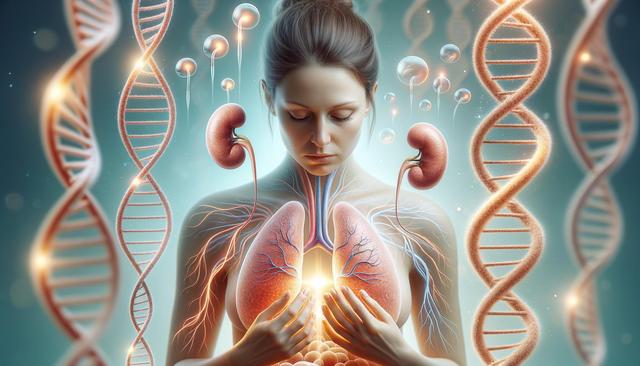Understanding Congenital Adrenal Hyperplasia in Females
Congenital adrenal hyperplasia (CAH) is a group of inherited genetic conditions involving the adrenal glands, which are responsible for producing essential hormones. In females, CAH can significantly affect physical development and hormonal balance, particularly during childhood and adolescence. Unlike many other genetic disorders, CAH in females often manifests through noticeable changes in secondary sexual characteristics and genital development. This is due to the overproduction of androgens, which are typically present in higher amounts in males. As a result, CAH in females can sometimes lead to what is clinically referred to as “cah intersex” characteristics, where external genitalia may appear more typically male at birth.
One of the distinguishing features of CAH in girls is the early onset of symptoms. While other genetic disorders may not become apparent until later in life or may present with subtle issues, CAH frequently reveals itself through signs such as ambiguous genitalia, rapid growth in early childhood, and early signs of puberty. These developments often prompt early medical evaluations and may lead to the use of diagnostic tools, including imaging and hormone testing. Resources such as congenital adrenal hyperplasia pictures can provide valuable visual understanding for healthcare providers and families trying to comprehend the physical manifestations of this condition.
How CAH Differs from Other Genetic Disorders in Females
Several genetic disorders affect females, but CAH stands out due to its hormonal implications and physical manifestations. While conditions like Turner syndrome or Fragile X primarily involve chromosomal abnormalities or cognitive development challenges, CAH directly impacts the endocrine system. This leads to a distinct set of challenges including hormonal imbalances, issues with salt retention, and unique puberty patterns.
Some key differences include:
- Visible genital differences at birth, often leading to early diagnosis
- Hormonal management as a primary treatment focus, unlike surgical or genetic therapies in other disorders
- Early or irregular menstruation cycles, which can affect reproductive planning
- Greater emphasis on lifelong hormone replacement therapy
Because of these differences, the approach to medical care for girls with CAH is often multidisciplinary, involving endocrinologists, geneticists, and psychologists to support both physical and emotional well-being. Understanding the distinctions between cah girls and those with other genetic conditions helps in crafting more effective, personalized care strategies.
Puberty and Development in Girls with CAH
Puberty in girls with CAH often deviates from typical developmental patterns due to early exposure to excess androgens. This can lead to early or precocious puberty, which is characterized by the development of pubic hair, body odor, and acne at a younger-than-average age. In some cases, girls with untreated or poorly managed CAH may experience stunted growth due to early closure of growth plates.
Key differences observed during cah puberty include:
- Accelerated bone age resulting in shorter adult stature
- Irregular or absent menstruation cycles
- Masculinized body features, such as increased muscle mass or deeper voice
- Psychosocial effects due to early physical changes
Parents and caregivers often seek support during this period, as navigating puberty with CAH requires consistent medical oversight and emotional support. Treatment plans typically include hormone regulation through medications like glucocorticoids and mineralocorticoids, which help normalize hormone levels and mitigate the effects of excess androgens. Regular monitoring, including bone age assessments and hormone level checks, is critical during this stage.
Diagnostic Processes and Testing in Women
Accurate diagnosis of CAH typically begins in infancy, especially in cases where physical symptoms are apparent. However, milder forms like non-classic CAH may not be diagnosed until adolescence or adulthood, particularly in women who experience irregular periods, infertility, or excessive body hair. The process of cah testing women involves a combination of blood tests to measure hormone levels, genetic testing to confirm mutations in the CYP21A2 gene, and sometimes imaging studies to evaluate adrenal size and function.
Common diagnostic steps include:
- Newborn screening panels that detect elevated 17-hydroxyprogesterone levels
- ACTH stimulation tests to assess adrenal response
- Pelvic ultrasounds to examine reproductive organs
- Genetic counseling for affected individuals and families
These tests are essential for identifying both classic and non-classic forms of CAH. In adult women, identifying CAH can be particularly important for managing long-term health issues like adrenal crises, fertility concerns, and maintaining bone health. Early and accurate diagnosis facilitates timely treatment and improves quality of life for those affected.
Psychosocial and Identity Considerations in CAH
Living with CAH, especially for females, goes beyond physical health. The condition can have a profound impact on identity, social experiences, and mental well-being. Girls with CAH may face challenges related to body image, gender identity, and peer relationships, particularly if they exhibit physical features that differ from societal expectations. The term cah intersex is sometimes used to describe individuals whose genital appearance doesn’t fit typical definitions of male or female, which can add another layer of complexity to their personal experiences.
Supportive care for girls and women with CAH should consider:
- Access to mental health professionals experienced in gender and chronic health issues
- Peer support groups for individuals with CAH and their families
- Education and counseling about reproductive options
- Ongoing communication between healthcare providers and patients to address evolving needs
These psychosocial aspects are just as crucial as medical treatment. Providing a safe and informed environment helps individuals with CAH navigate their condition with confidence. Encouraging open conversations around topics like cah in females and body autonomy can promote resilience and foster a sense of empowerment.
Conclusion: Supporting Girls and Women Living with CAH
CAH in girls is a distinctive genetic condition that impacts physical development, hormonal balance, and psychosocial health from infancy through adulthood. Unlike many other genetic disorders, CAH in females often presents early and requires a multifaceted approach to care. With timely diagnosis, consistent monitoring, and strong emotional support, individuals with CAH can lead fulfilling lives. Understanding the unique challenges associated with CAH — including cah puberty, cah testing women, and the impact of cah intersex traits — enables better support for both patients and their families. As awareness and research continue to grow, so does the potential to improve outcomes and enhance the quality of life for those affected.



Leave a Reply